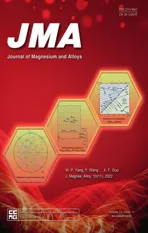Nucleation of recrystallization in magnesium alloy grains of varied orientation and the impacts on texture evolution
2022-12-30VitoriaMillerJianFengNieTresaPollok
Vitoria M.Miller,Jian-Feng Nie,Tresa M.Pollok
a Department of Materials Science and Engineering,University of Florida,Gainesville,FL 32611,USA
b Department of Materials Science and Engineering,Monash University,Victoria 3800,Australia
c Materials Department,University of California Santa Barbara,Santa Barbara,CA 93106-5050,USA
Abstract Selection of appropriate thermomechanical processing parameters is crucial for control of the crystallographic texture and grain size distribution in wrought magnesium alloys,which in turn dictate their mechanical properties.In this work,the recrystallization behavior of binary Mg-Zn alloys are examined after warm rolling as a function of alloy content and heat treatment temperature.The Avrami exponent increased with increasing heat treatment temperature up to the MgZn solvus,while the strength of the recrystallization texture decreased.Neither the Avrami exponent nor the qualitative trends in texture evolution were sensitive to the Zn alloying content in the examined range.EBSD and transmission electron microscopy observations revealed that the changes in texture and recrystallization kinetics could be attributed to differences in the nucleation behavior of basal and off-basal orientations.
Keywords: Magnesium alloys;Recrystallization;Dislocation substructure;Texture.
1.Introduction
Wrought magnesium,particularly magnesium sheet product,lacks sufficien formability for widespread adoption;instead,it is limited to low volume niche applications because of the energy- and cost-intensive processes required to produce formable sheet.Increasing the room temperature formability would substantially broaden the pool of potential applications,including automotive and consumer electronic markets.
The underlying reason for the poor room temperature formability of conventional magnesium sheet alloys is the strong crystallographic texture that develops during thermomechanical processing due to the inherent plastic anisotropy of magnesium [1–8].During the production of rolled sheet,the basal poles of the Mg alloy grains tend to align with the sheet normal.In this orientation there are limited easy deformation modes available to accommodate through-thickness sheet strains which are present in sheet forming operations [9].Efforts to improve sheet formability have generally focused on the production of sheet with weak texture,but formability is also enhanced in textured sheet where the primary texture component is non-basal [10].
Opportunities for texture modificatio are present both during deformation and during recrystallization.During deformation,texture modificatio strategies include both alloy additions (particularly rare earth additions) and modification to the deformation pathway.Rare earth and alkaline earth solute additions promote a weaker,more diffuse deformation texture,frequently with some transverse direction spread in the basal pole figure of rolled material;however,they do not dramatically change the components of the developed deformation texture[11–20].Non-traditional deformation pathways(e.g.differential speed rolling [21],upset forging [22],shearassisted processing and extrusion [23,24],electric pulse current assisted rolling [19,25] or equal channel angular pressing [26,27]) also produce either weakened textures or non-basal textures,both of which can result in improved formability.The addition of large (greater than approximately 1μm diameter) intermetallic particles produces similar effects on deformation texture even in rare-earth-free alloys,weakening the intensity of the basal peak and promoting spread of the basal poles toward the transverse direction [3,19,28–32].
Texture modificatio during recrystallization has most frequently been reported in rare-earth-containing magnesium alloys.Recrystallization in these alloys is often reported to result in the formation of a new texture component.In extruded material,the new component manifests as a peak between[0001] and[15,17,33–38].This new texture component is less obvious in pole figure of rolled material due to the specimen symmetry,but generally results in greater spread of the basal poles toward the transverse direction or is sometimes simply described as a weaker more diffuse basal texture [16,17].The rare earth texture effect can be amplifie by other non-rare earth solutes,including Zn and Ca [39,40].
In rare-earth-free magnesium alloys,the basal texture developed during deformation typically persists through recrystallization;this is largely due to the nature of the active recrystallization mechanisms.Most commonly reported are continuous recrystallization via subgrain coalescence and discontinuous necklace recrystallization [41–49].However,none of these mechanisms result in substantial realignment of the basal poles,so the strength of the basal peak remains largely unchanged through recrystallization.In some systems with coarse intermetallic particles,particle stimulated nucleation of recrystallization has also been observed and can result in a more diffuse texture [50,51];however,in most wrought alloys the volume fraction of coarse intermetallic particles is insufficien for particle stimulated nucleation to sufficientl weaken the overall texture.Strengthening of the basal texture has been reported during grain growth after primary recrystallization[16,49,52,53].However,there is some recent evidence that under certain conditions weakened recrystallization textures may be achieved even in rare-earth-free alloys [29,54].
In this work,opportunities for minimization of texture intensity during recrystallization are sought by varying the alloying and process parameters.The microstructural and texture evolution during static recrystallization are examined for Mg-Zn binary alloys with varied fractions of intermetallic particles and during heat treatments at several temperatures.The differences in recrystallization kinetics across the processing conditions are investigated and related to the nucleation mechanisms available in grains of differing orientation.
2.Experimental Procedures
2.1.Alloy and processing
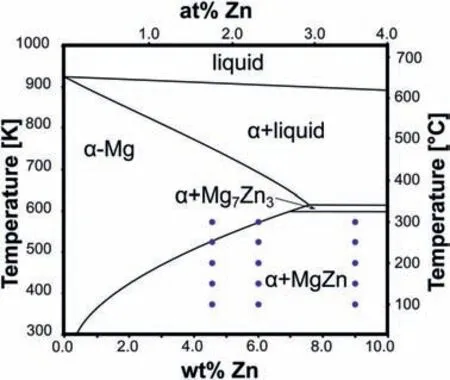
Fig.1.Mg-rich side of the binary Mg-Zn phase diagram,as calculated by Pandat with the PanMagnesium database[55].Examined alloy and heat treatment combinations are marked.
Three binary Mg-Zn alloys with nominally 4.5wt%,6wt%,and 9wt% Zn were cast and pre-processed at Monash University in Clayton,VIC.The real alloy compositions were 4.48wt% Zn,5.76wt% Zn,and 8.99wt% Zn,respectively.These alloy compositions were selected because they fall in the two-phase region of the phase diagram at all processing temperatures below 250◦C,and therefore have an equilibrium population of MgZn intermetallic particles [55],as illustrated in Fig.1.In the as-solidifie condition,the intermetallic is most likely Mg7Zn3[56,57],but this phase transforms to the equilibrium MgZn phase upon heat treatment [58].The equilibrium molar phase fractions are listed in Table 1.These are converted to approximate equilibrium volume fractions as a function of temperature using a theoretical density for the MgZn crystal structure reported by Gao and Nie [58].Note that the phases present in the material may not be fully transformed to the equilibrium phase.
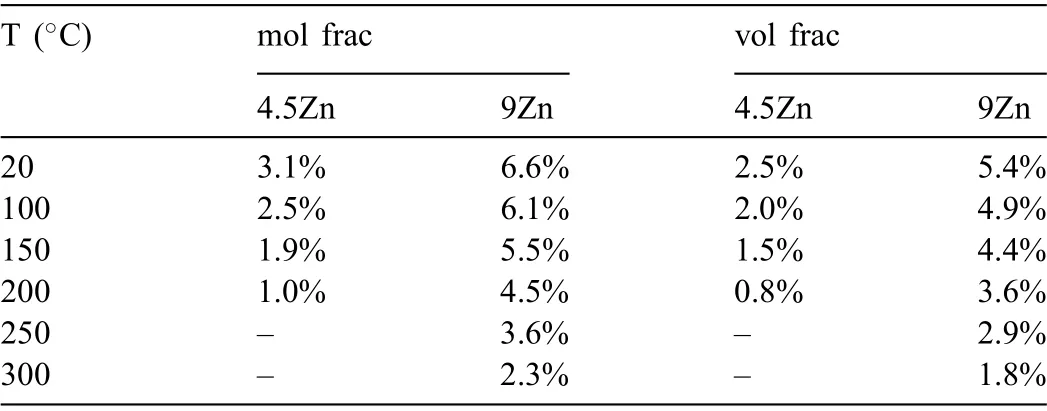
Table 1 Equilibrium phase fractions for the MgZn phase.
This work was part of a larger study on the texture evolution during thermomechanical processing in the Mg-Zn binary system and uses the same material from Reference [59].To prepare the alloys,nominally pure Mg and Zn were heated to 719◦C for melting and poured into 30mm by 50mm rectangular steel molds preheated to 200◦C.The as-solidifie ingots were firs heat treated at 300◦C for 2 hours in air,then cooled at 1.25◦C per minute to 250◦C and held for 16 hours,then water quenched.This heat treatment developed a relatively homogeneous distribution of fin precipitates in addition to the existing coarse intermetallic particles.More detailed characterization of the microstructure through each stage of pre-processing may be found in Reference [59].This alloy was then extruded at 250◦C with an extrusion ratio of 32:1 to refin the grains and produce a 3mm by 10mm rectangular cross section suitable for rolling.After extrusion,the precipitates were nominally spherical,approximately 100nm in diameter,and no longer coherent with the Mg matrix [59].

Fig.2.Backscattered electron images of the as-rolled 4.5wt% and 9wt% microstructures illustrating the distribution of intermetallic particles.
This preprocessed material was then subjected to warm rolling deformation and subsequent static heat treatment to study the recrystallization behavior.Sections of the extrudate were preheated in air for 5 minutes at 150◦C using a box furnace.These specimens were warm rolled to a 40% reduction in thickness in a single pass with a rolling temperature of 150◦C and an approximate rolling speed of 10mm/s.In all cases,the rolling direction is parallel to the prior extrusion direction.The samples were quenched in water at the conclusion of deformation,and the resulting microstructure is shown in Fig.2.
Additional preprocessed material was subjected to cold rolling to a 7% reduction in thickness in a single pass to examine the early stages of dislocation substructure development.These specimens were prepared for transmission electron microscopy investigation,as described below.
Isothermal heat treatments on 10mm square sheet specimens were conducted at temperatures from 100◦C to 300◦C in 50◦C increments.At 200◦C and below,heat treatments were conducted in a silicone oil bath;above 200◦C,specimens were wrapped in Al foil and heat treated in a nitrate salt bath.At the conclusion of each heat treatment,the specimen was water quenched.
2.2.Microstructural characterization
Samples for scanning electron microscopy and electron backscatter diffraction(EBSD)were prepared by conventional metallographic techniques.Sections were cut with a low speed diamond saw,then ground and polished with SiC papers using water as a lubricant,ending with 1200 grit paper.Polishing was then conducted with diamond lapping film with 9,3,and 1μm abrasive sizes with methanol as a lubricant.Final surface preparation for electron backscatter diffraction consisted of argon ion milling with a Gatan Precision Ion Polishing System at an operating voltage of 4kV for 30 minutes followed by 2kV for 10 minutes.
Backscattered scanning electron microscopy imaging was conducted on the electron backscatter diffraction-quality surfaces using an FEI XL30 scanning electron microscopy operating at 10kV accelerating voltage,a spot size of 3,and a working distance of 5mm.electron backscatter diffraction characterization with a EDAX Hikari high speed camera was conducted on the same microscope operating at 20kV and a spot size of 5.Large scans for quantitative crystallographic texture measurement of the deformed and heat treated specimens were run with a step size of 0.3μm and 4 by 4 camera binning conducted over an area containing at least 10,000 grains after cleanup.The cleanup routine employed for the texture scans solely consisted of removing any data belonging to grains smaller than 5 sampling points.Smaller scans at step sizes ranging from 100 to 300nm with 2 by 2 camera binning were conducted on heat treated specimens to examine the partially recrystallized microstructures.

Fig.3.Evolution of Vickers microhardness during heat treatment at temperatures between 100◦C and 300◦C.
Samples for transmission electron microscopy investigation of dislocation substructure were prepared by either argon ion milling or site-specifi liftout using a focused ion beam microscope.Specimens for argon ion milling were mechanically polished on diamond lapping film to a fina thickness of 60μm using methanol as a lubricant and with 1μm as a fina abrasive size.These disks were then argon ion milled using the Gatan Precision Ion Polishing System in two steps.First,the disks were milled at liquid nitrogen temperatures using 5kV accelerating voltage at gun tilts of ±5◦until perforation.The perforated disks were then milled at 2.5kV and ±2◦gun tilt for 30 min for fina cleaning.Site-specifi foils were extracted using a focused ion beam liftout technique in an FEI Helios Dualbeam Nanolab 650 microscope equipped with an OmniProbe system,with the regions of interest selected using electron backscatter diffraction.transmission electron microscopy observation was conducted using an FEI T20 Technai microscope operating at 200kV.
2.3.Measurement of fraction recrystallized
Following heat treatment,the fraction of recrystallized materialfRXwas measured via Vickers microhardness with a 200g load,such that

whereHmaxis the as-deformed (maximum) hardness,Hminis the fully recrystallized (minimum) hardness achieved for the alloy/temperature,andHis the measured partially recrystallized hardness,after Ref.[3,60].
3.Results
The roles of the varied phase fraction of intermetallic particles and recrystallization temperature were firs examined on the basis of the kinetics of recrystallization,then the mechanisms underlying differences in recrystallization texture were examined.
3.1.Recrystallization kinetics
Vickers microhardness was used as a metric to track the progress of recrystallization,as discussed in Section 2.3.The evolution of microhardness for each of the three alloys is shown in Fig.3.The variability in measured microhardness values is relatively low.Distinct recovery plateaus are present at all of the lower temperatures.As shown,the minimum hardnesses achieved are similar within each alloy for all of the temperatures,with the exception of 300◦C.Small variations in the minimum hardnesses are observed,with higher annealing temperatures resulting in slightly lower values of minimum hardness.This would be consistent with the expected reduction in volume fraction of pinning precipitates at higher temperatures.
These hardness values were converted to fractions recrystallized and the recrystallization kinetics at each temperature were analyzed using the Johnson-Mehl-Avrami-Kolmogorov model [61].In this model,the fraction recrystallized,fRX,is related to the annealing time,t,by the equation:
fRX=1 −exp(−Btn)
whereBcontains geometric terms and the nucleation and growth rates in the analytical form andnis the Avrami exponent.Experimentally,Bandnare used as fittin parameters.The Avrami model assumes that nucleation and growth rates are spatially and temporally constant during recrystallization and that the nuclei are randomly distributed.
Linearized Avrami fit were calculated at each temperature for each alloy.The calculated Avrami exponent for each alloy-temperature combination is presented in Table 2 and plotted over the data in Fig.4.As shown,there is minimal variability in the recrystallization kinetics at a given temperature between the three alloys.However,the Avrami exponent varies substantially as a function of temperature,with greater recrystallization temperatures resulting in higher Avrami exponents with the exception of recrystallization at 300◦C.Additionally,there is substantial spread in the data at short times for the lower temperatures,likely due to the observed recovery plateau.At longer times,the spread of the data around the fi is substantially reduced.
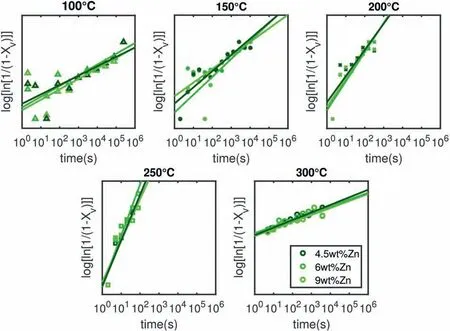
Fig.4.Johnson-Mehl-Avrami-Kolmogorov kinetics as a function of temperature for each Mg-Zn binary alloy.

Table 2 Avrami exponent for each alloy composition at each recrystallization temperature
3.2.Recrystallization textures
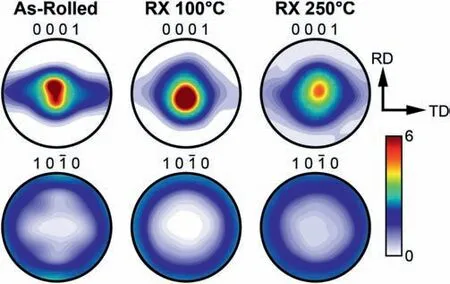
Fig.5.Textures for the Mg-9Zn alloy at the completion of recrystallization for two temperatures,100◦C and 250◦C.As 300◦C is above the precipitate solvus,the behavior at this temperature is considered separately in 3.5.
The as-rolled and fully recrystallized textures at 100◦C and 250◦C for the 9wt%Zn alloy are presented in Fig.5.Recrystallization at higher temperatures up to 250◦C resulted in a weaker,more diffuse basal peak with greater retained transverse direction spread,whereas recrystallization at a lower temperature resulted in diminished transverse direction spread and a sharper,stronger basal peak.Recrystallization at 300◦C resulted in different behavior,discussed in Section 3.5.The variation in heat treatment conditions and alloying content did not substantially modify the recrystallized grain size;all measured grain sizes were approximately 2-3μm equivalent circular diameter.electron backscatter diffraction-measured grain sizes are presented in Table 3.The same trend is observed in the 4.5wt%Zn and 6wt%Zn alloys,but is more apparent in the 9wt%Zn alloy due to the greater spread of the basal poles in the as-deformed state.

Fig.6.Mg-9wt%Zn alloy in the as-rolled structure.An inverse pole figur and an image quality map referenced to the sheet normal direction are shown.

Table 3 Mean recrystallized grain diameters.The indicated uncertainty is one standard deviation.
3.3.Partially recrystallized microstructures
To investigate the origin of the recrystallization kinetics and texture variation with heat treatment temperature,partially recrystallized microstructures of the 9wt%Zn alloy were observed using electron backscatter diffraction and transmission electron microscopy.
The as-rolled 9wt%Zn microstructure is presented in Fig.6 as an inverse pole figur (IPF)and image quality map.The asrolled microstructure is generally well-indexed;however,there were regions too severely deformed for successful indexing.In the image quality map,nearly the full microstructure is dark contrast for both basal and non-basal orientations,indicating that dynamic recrystallization was not active.Grains having basal (red in IPF key) versus off-basal (yellow-green)orientation occur in colonies elongated in the prior extrusion direction,which is parallel to the rolling direction.To qualitatively compare the stored deformation energy (i.e.,driving force for recrystallization) for grains of different orientations,grain orientation spread was compared for basal (basal pole tilt less than 25◦) and non-basal (basal pole tilt greater than 25◦) grains.The area fractions of grains with particular grain orientation spread values are plotted for basal and non-basal grains in Fig.7.

Fig.7.Grain orientation spread profile for grains with basal pole tilt below(basal) and above (off-basal) 25◦.The grain orientation spread profile are approximately equal.
The microstructure of the rolled material heat treated for 16 hours at 150◦C is shown in Fig.8 as an image quality map,an inverse pole figur map referenced to the normal direction,and a discrete pole figure Definin the homologous temperature,Th,as the heat treatment temperature divided by the solidus temperature for the composition,150◦C corresponds toTh=0.69.In the inverse pole figur map,grain boundaries with disorientations above 5◦are indicated by a black line.The basal grains are approximately equiaxed and have bright contrast in the image quality map,indicating that they are recrystallized.However,many of the off-basal grains remain elongated and dark contrast in the image quality map,suggesting that they have not yet recrystallized.Some highly elongated grains formed during the extrusion process also persist in the unrecrystallized state.These grains are extremely resistant to recrystallization,failing to dynamically recrystallize during pre-processing and during subsequent rolling and heat treatment.All of these grains retained from the extrusion pre-preprocessing were of off-basal orientation.

Fig.8.Mg-9wt%Zn alloy heat treated at 150◦C for 16 hours.An image quality map,an inverse pole figur map referenced to the normal direction,and the discrete basal pole figur with the same coloring as the inverse pole figur map are shown.The basal grains (near-red) are fully recrystallized,while the off-basal grains (yellow-green) remain in the as-deformed state.
In comparison,the microstructure of rolled material heat treated for 5 minutes at 250◦C is shown in Fig.9.At this higher temperature (Th=0.85),all orientations are approximately equiaxed and appear in bright contrast in the image quality map,suggesting that both basal and off-basal orientations recrystallized.
3.4.Dislocation substructure of specimens rolled to small strains
The early stages of dislocation substructure development were investigated via transmission electron microscopy in material rolled to a 7% reduction in thickness in a single pass.Foils were extracted from grains with basal pole tilt values near zero and greater than 25◦to examine the orientation dependence of substructure development.
The substructure observed in basal and non-basal grains is presented in Fig.10 as transmission electron microscopy brightfiel images and explanatory schematic diagrams.In the basal grain,three subgrains separated by multiple non-parallel low angle grain boundaries composed of dislocation walls are present.Under this diffraction condition,〈a〉-type dislocations should be invisible,but appear in weak contrast likely due to the strong lattice curvature.Conversely,dislocations with a〈c〉 component appear in strong contrast as illustrated in the lower third of the middle subgrain.The low angle boundaries to the left and right of the middle subgrain are composed of 〈a〉-type dislocations lying in different planes.The geometry of the the left dislocation wall is most consistent with basal dislocations,while the geometry of the wall on the right is most consistent with prismatic dislocations.The prismatic wall on the right is particularly well-defined resulting in a subgrain misorientation of approximately 3◦.
In the off-basal grain,a deformation twin is present in bright contrast.Also visible are large number dislocations in the non-twin region.These dislocations organize themselves into bands of high density near horizontal in the image.Imaging under additional diffraction conditions indicated that these bands of high dislocation density are primarily composed of dislocations of a single Burgers vector,as shown schematically.
3.5.Recrystallization behavior at 300◦C

Fig.9.Mg-9wt%Zn alloy heat treated at 250◦C for 5 minutes.Both basal and off-basal grains successfully recrystallized.Remnants of the colony structure produced during extrusion are still present,as indicated with arrows.
Recrystallization at 300◦C did not adhere to the trend of increasing Avrami exponent with increased recrystallization temperature;instead,very low Avrami exponents were calculated.electron backscatter diffraction investigation of the microstructure and texture revealed a very strong basal texture with effectively no retained transverse direction spread and a substantially coarser recrystallized grain size than observed at lower temperatures,as shown in Fig.11.Additionally,the hardness after recrystallization was substantially lower than recrystallization at other temperatures.The results at 300◦C are likely related to grain growth rather than recrystallization,as discussed further in Section 4.3.
4.Discussion
In the preceding section,the variation in static recrystallization kinetics of three different Mg-Zn binary alloys were examined during heat treatment at temperatures from 100◦C to 300◦C.The grain and dislocation scale mechanisms contributing to the variation in kinetics and the resulting variations in crystallographic texture were investigated using electron backscatter diffraction and transmission electron microscopy.The calculated Avrami exponents increased with temperature up to 250◦C,and larger Avrami exponents corresponded to weaker recrystallization textures.electron backscatter diffraction investigation revealed that,at all examined temperatures,grains with basal orientations typically recrystallized earlier than grains with off basal orientations.Differences in dislocation substructure were observed in grains of different orientations,which can be directly related to the varied recrystallization kinetics.
4.1.The Johnson-Mehl-Avrami-Kolmogorov model of recrystallization kinetics
The calculated Avrami exponents did not have any dependence on the alloy content.All three alloys are above the solution limit and primarily differ in the volume fraction of coarse intermetallic particles,suggesting that the intermetallic particles did not play a substantial role in primary recrystallization kinetics.This indicates that particle stimulated nucleation of recrystallization is not an important contributor to the overall recrystallization kinetics in these alloys.This is in contrast to recent results in other particle-containing magnesium alloys [29,50,54,62];however,it is consistent with the observations of Robson et al.[51] in Mg-Mn alloys.Instead of particle stimulated nucleation,the predominant nucleation site is most likely pre-existing high angle grain boundaries.However,the fin grain size of the parent structure makes this difficul to directly observe.
The observed Avrami exponents deviate substantially from the theoretical Johnson-Mehl-Avrami-Kolmogorov model.In the Johnson-Mehl-Avrami-Kolmogorov model of recrystallization kinetics,spherical recrystallization nuclei are assumed to grow at a constant rate into a homogeneous deformed matrix until impingement occurs.The nucleation sites are assumed homogeneously distributed,but different assumptions about the nucleation rate can be made.The two limiting cases are site-saturated nucleation and a constant nucleation rate;the resulting Avrami exponents for these two cases (assuming a three-dimensional material) are 3 and 4,respectively [61].

Fig.10.Comparison of dislocation substructure in basal versus off-basal grains.Upper images show transmission electron microscopy bright fiel images,and the lower images are schematic representations showing the locations of low angle boundaries and the orientation of the foil and the crystal.

Fig.11.inverse pole figur map and pole figure for 9wt%Zn material recrystallized at 300◦C.
The Avrami exponents found in this work are all substantially lower than the theoretical bounds,ranging from approximately 0.5 at 100◦C to greater than 2 at 250◦C.Avrami exponents lower than the theoretical values are not uncommon in engineering materials because of the unrealistic model assumption that the recrystallization nuclei are randomly distributed.However,the large variability in the Avrami exponent with temperature is atypical.Many materials are reported to maintain approximately the same Avrami exponent during recrystallization over a wide range of temperatures [61,63].The increase in Avrami exponent with temperature suggests that nucleation more closely adheres to the assumptions of the Johnson-Mehl-Avrami-Kolmogorov model at higher temperatures,i.e.,the nucleation of recrystallization becomes more spatially random at higher homologous temperatures.
4.2.Microstructural effects on homogeneity of nucleation
The change in the spatial homogeneity of nucleation of recrystallization with heat treatment temperature is also supported by the electron backscatter diffraction results presented in Section 3.3.At low temperatures,the basal grains preferentially recrystallize relative to grains with off-basal orientations.At elevated temperatures,both basal and off-basal orientations recrystallize early in the heat treatment.
In this work,the basal versus off-basal grains occur in clusters.This colony-like arrangement of basal and off-basal grains in the as-deformed microstructure likely results from the extrusion pre-processing.The colonies of grains having similar orientation have been commonly reported to result from a single parent grain in the pre-extrusion microstructure.Orientations do not dramatically change during subsequent recrystallization cycles,resulting in apparent colonies.Other authors have reported that extrudate often retains unrecrystallized grains of a specifi orientation,where grains of other orientations undergo dynamic recrystallization during the extrusion process [64–67].Additionally,the colony-like structure of recrystallized grains has been previously observed by several authors in extrudate [68].
In the previous work of Azeem et al.[64] on extruded AZ21,grains with a c-axis perpendicular (within 5◦) of the extrusion direction did not recrystallize even after static annealing.Grains with c-axes nearly aligned with the extrusion direction underwent nucleation-limited recrystallization,forming coarse grained colonies.Grains of other orientations readily underwent dynamic recrystallization and formed a fin grained matrix.However,these previous studies looked at the partially dynamic recrystallization extrudate;it was not possible to compare the as-deformed structure for all grain orientations.The present study directly examines for the firs time the origins of orientation-dependent nucleation in Mg alloys starting from the as-deformed structure.
Orientation dependence of the nucleation of recrystallization must either stem from thermodynamics—i.e.,a difference in the driving force for recrystallization—or from kinetic effects.The results of this study suggest that there is very little difference in the driving forces for recrystallization between basal and off-basal grains.The grain orientation spread profile for basal and off-basal grains are nearly identical(Fig.7),suggesting that the amounts of internal dislocation storage are comparable to the extent that can be measured with electron backscatter diffraction.electron backscatter diffraction can only measure the geometrically necessary dislocation content;it does not have the ability to measure statistically stored dislocations,but other authors have assumed that the total dislocation density will scale with the electron backscatter diffraction-measurable geometrically necessary dislocation content [69–71].Additionally,grain orientation spread will only give a qualitative indication of geometrically necessary dislocation content.Nonetheless,within the scope of this experiment the difference in behavior is more likely attributable to kinetics,rather than a difference in thermodynamic driving force.
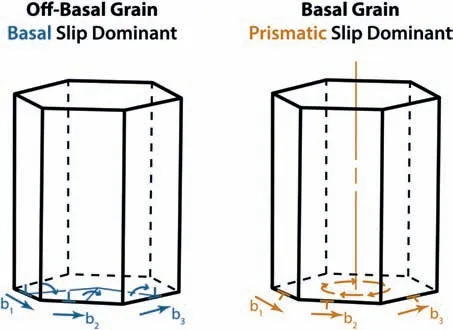
Fig.12.Comparison of the preferred Taylor axes in basal and off-basal grains,based on the active deformation mechanisms.In basal grains,prismatic dislocations of all three Burgers vectors share a common Taylor axis,while in off-basal grains the three basal Burgers vectors have different Taylor axes.
These differences in the kinetics of nucleation of recrystallization with varied grain orientation can be understood by considering the differences in dislocation content postdeformation.As discussed by Koike and Ohyama [72],basal pole tilt provides a simple geometrical criterion for the conditions under which prismatic versus basal slip is dominant.Under the loading conditions of rolling,prismatic slip will dominate in the near-basal grains.Conversely,basal slip will dominate in grains with high TD tilts due to the lower critical resolved shear stress.A population of dislocations of a particular slip family will result in curvature around a particular crystallographic axis,called the Taylor axis for that slip system.All possible Taylor axes in hcp materials are reported in Refs [14] and are plotted schematically in [29].Dislocations from the basal and prismatic slip systems have very different Taylor axes,as shown in Fig.12.All slip systems in the prismatic slip family share a common Taylor axis parallel to the〈c〉 axis.Conversely,each individual basal slip system results in curvature around a different direction in thefamily,perpendicular to the Burgers vector.Hadorn et al.[14] hypothesized that with multiple populations of dislocations with different Burgers vectors acting cooperatively it is possible to accumulate greater subgrain misorientation before rotation is limited by elastic strain than in the case of only a single population of dislocations.Sufficien subgrain misorientation is typically reported to be a prerequisite for viable nucleation during recrystallization [61],and Sabat et al.[73] found that the formation of very low angle boundaries was the limiting step in the formation of recrystallization nuclei in pure Mg.
The hypothesis of more efficien nucleation in basal grains where prismatic slip is most favorable is borne out by the transmission electron microscopy and electron backscatter diffraction work in the present study.As shown in Fig.10,the off-basal grains form dislocation walls;however,they are long and parallel,which does not result in a viable recrystallization nucleus.On the other hand,multiple non-parallel dislocation walls were observed in the basal grain.These walls were primarily composed of prismatic dislocations,and therefore would allow for efficien sub-division of the parent grain as well as cooperative rotation around a common Taylor axis.Notably,this common Taylor axis is the 〈c〉 axis,so recrystallization of basal grains occurring by this mechanism would not alter the strength of the basal texture.
At low recrystallization temperatures,this difference in efficien y of formation of highly misoriented subgrains is exacerbated,whereas at high temperatures the enhanced thermally activated recovery reduces the difference between basal and off-basal grain recovery.This difference in nucleation behavior is a likely explanation for electron backscatter diffractionobserved orientation dependent behavior of nucleation of recrystallization.With the delayed nucleation in off-basal grains at low temperatures,the off-basal grains are likely to be consumed by the advancing (basal-oriented) recrystallization front,leading to texture strengthening.Interestingly,at 250◦C (Fig.9) when nucleation does occur in the off-basal grains,they grow to comparable and often slightly larger sizes than their basal counterparts.There is apparently no barrier to their growth after successful nucleation.The larger size is most likely attributed to the scarcity of nuclei,as other researchers have not observed significan growth rate differences for basal versus off-basal orientations [64,74].
4.3.The impact of Zener pinning on the recrystallized grain size
At all heat treatment temperatures with the exception of 300◦C,the recrystallized grain size is approximately constant,with the mean grain size varying between 2 and 3.0 μm for all measured alloy and temperature combinations.This similarity in grain size is likely the result of Zener drag [75].According to the Zener analysis,when the particle pinning pressure is equal to the driving pressure for grain growth a limiting grain size is achieved.This limiting grain size can be calculated using the relationship [61]:

In this equation,ris the particle radius,FVis the particle volume fraction,andαis a geometric parameter near one.While there have been numerous attempts to refin the Zener analysis [76],most of the predictions result in a limiting grain size relationship similar to that predicted by the Zener equation,with the value ofαbetween 0.25 and 0.5.
For the fin particle distribution in the 9wt%Zn alloy at room temperature,the Zener analysis produces the values shown in Table 4 for several values ofα.As shown,the experimentally observed grain diameters are very near the predicted Zener limit for values ofαnear 1.0;the re-sults do not deviate substantially even at the elevated temperature equilibrium volume fractions.This suggests that the distribution of fin intermetallic particles is effective in restricting the recrystallized grain size.The prevention of grain growth after impingement is critical to prevent texture strengthening [52].

Table 4 Zener-limiting grain size for various values of α
The importance of the population of fin pinning particles is reinforced by the results of heat treatment at 300◦C.At this temperature,substantially coarser grain sizes and a stronger basal texture are obtained,and a much smaller Avrami exponent is calculated.The minimum Vickers hardness value obtained is also substantially smaller for alloys heat treated at 300◦C.It is likely that in the absence of pinning particles,initial recrystallization is immediately followed by a phase of rapid grain growth,so the two effects are ultimately conflate in the Johnson-Mehl-Avrami-Kolmogorov analysis,explaining the anomalously low Avrami exponent.In the absence of pinning particles,grain growth likely continues until “orientation pinning” becomes too strong when similarly oriented basal grains impinge.Clearly,the fin particle population is necessary for the retention of the fin grain size and weak texture.
5.Conclusions
In this study,the static recrystallization kinetics and their responsible mechanisms are investigated over a range of heat treatment temperatures and varied intermetallic particle fractions in binary Mg-Zn alloys.The following conclusions can be drawn:
•The Avrami exponent for recrystallization increases from approximately 0.5 to approximately 2.5 with increasing temperature up to 250◦C,indicating that recrystallization becomes more spatially homogeneous with increasing temperature.
•The recrystallization kinetics in the examined alloys are not sensitive to the Zn content in the examined range,suggesting that particle stimulated nucleation is not a dominant nucleation mechanism.
•Stronger recrystallization textures with reduced spread of the basal poles were observed after recrystallization at lower temperatures.
•electron backscatter diffraction observation revealed differences in nucleation behavior between basal-oriented and off-basal grains,with a substantial delay in nucleation of recrystallization in off-basal grains occurring at low temperatures.This delay of nucleation resulted in growth of recrystallized basal grains into the unrecrystallized off-basal regions.The strengthened basal texture during static recrystallization at lower temperatures is attributed to this effect.
•transmission electron microscopy observations of the deformed state developed in basal versus off-basal grains reveal differences in dislocation substructure.In basal grains,high prismatic slip activity allows multiple non-parallel dislocation walls to subdivide the parent grain,resulting in efficien nucleation.Conversely,in off-basal grains easy basal slip leads to only a single population of dislocation walls and inefficien nucleus formation.
•The discussed trends in recrystallization behavior with temperature were broken during recrystallization at 300◦C.This is attributed to the dissolution of the population of fin particles.This dissolution allowed for substantially more grain growth and a recrystallized grain size more than fi e times greater than at any other examined temperature.Strengthening of the basal texture occurred concurrently with this grain growth.
Declaration of Competing Interest
The authors declare that they have no known competing financia interests or personal relationships that could have appeared to influenc the work reported in this paper.
Acknowledgments
V.M.Miller thanks the University of California Santa Barbara for the support of a Regents’ Special Fellowship and T.M.Pollock acknowledges the support of Offic of Naval Research Grant number N00014-17-1-2810.The MRL Shared Experimental Facilities are supported by the MRSEC Program of the NSF under Award No.DMR 1121053;a member of the NSF-funded Materials Research Facilities Network(www.mrfn.org).This work was partially supported by the IMI Program of the National Science Foundation under Award No.DMR 08-43934.J.F.Nie acknowledges the support of the Australian Research Council.
杂志排行
Journal of Magnesium and Alloys的其它文章
- Grain refinemen of Mg-alloys by native MgO particles: An overview
- Tailoring MgH2 for hydrogen storage through nanoengineering and catalysis
- In silico studies of magnesium-based implants: A review of the current stage and challenges
- Investigating local corrosion processes of magnesium alloys with scanning probe electrochemical techniques: A review
- A tightly bonded reduced graphene oxide coating on magnesium alloy with photothermal effect for tumor therapy
- A novel nanoporous Mg-Li material for efficien hydrogen generation
